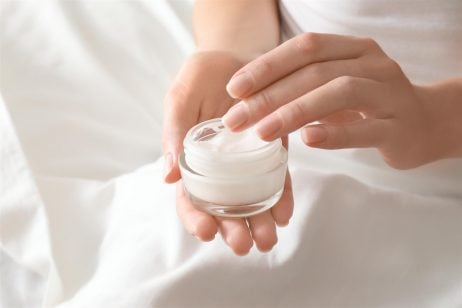Biossance is a beauty brand known for their use of sugarcane-derived squalane throughout their entire collection of skin care products, and their 100% non-nano, non-toxic mineral sunscreen is no exception.
The Biossance Sunscreen — formally known as Squalane + Zinc Sheer Mineral Sunscreen — is guaranteed to protect the skin without leaving behind a white cast like most mineral sunscreens. Its lightweight texture blends into all skin tones, leaving a soft, dewy finish.
But is the Biossance Sunscreen right for you? To help you decide, we’ll give you all the details on the key ingredients in this formula, as well as the research that supports (or doesn’t support) their use in skin care. We’ll also share some Biossance Sunscreen reviews so that you can get an idea of what customers really think of this product.
Is Biossance Sunscreen Right For You?
Before we get into the details, here’s the TL;DR if you just want to know whether or not Biossance Sunscreen is right for you.
- Key ingredients? Zinc Oxide, Squalane, Water Lily Extract
- Skin type? All skin types
- Texture? Lightweight lotion
- Fragrance? No
- Cruelty free? Yes
- Cost? $30 USD for 1.7 oz (50 mL) and $42 USD for 3.38 oz (100 mL).
What Are The Key Ingredients in Biossance Sunscreen?
One thing we love about the Biossance Sunscreen is that it’s EWG-verified. When a product is verified by the EWG (Environmental Working Group), that means it’s free from chemicals and ingredients that are harmful to your health, such as endocrine disruptors, synthetic fragrances, formaldehyde releasers, and more.
Now that you know that Biossance Sunscreen doesn’t contain any chemicals that are harmful to your health, let’s take a look at the key ingredients in this formula and how they will benefit your skin.
Zinc Oxide
The active ingredient in Biossance Sunscreen is non-nano, reef-safe zinc oxide, a physical sunscreen. Physical sunscreens work by using physical UV filters to block or deflect the sun’s UV rays.
Physical sunscreens tend to be tolerated well by most skin types because they are not absorbed into the skin. Thus, they are especially useful for those with heat sensitive skin (i.e. rosacea patients) as well as those with acne-prone skin as they are typically less pore-clogging.
The 14% concentration of zinc oxide in the Biossance Sunscreen provides broad spectrum SPF 30 protection. According to the FDA, broad spectrum means that the sunscreen can protect you from the sun’s harmful ultraviolet A (UVA) and ultraviolet B (UVB) rays.
You may be aware that physical sunscreens like zinc oxide can leave that dreaded white cast after application. However, Biossance Sunscreen is formulated to blend in for all skin tones fast without leaving a trace.
Squalane
As we mentioned earlier, squalane is the key ingredient that you’ll find in all Biossance skin care products, including the Biossance Sunscreen. But what exactly is squalane? And how can it benefit your skin?
First, it’s important to know that your skin contains its own version of squalane known as squalene (note the e).
Squalene is the biochemical precursor to cholesterol and the whole family of steroid hormones in the human body. It’s produced by the oil glands in the skin, and plays an important role in skin lubrication and protection.
However, the amount made and retained in the skin decreases over time. It peaks in our teens and then starts to decline in our 20’s, leaving skin rough, dry, and vulnerable.
According to a publication in the journal Advances in Food and Nutrition Research, anticancer, antioxidant, detoxifying, skin hydrating, and emollient activities of both squalene and squalane have been reported both in animal models and in vitro environments.
Since squalene is very unstable, Biossance uses squalane because it’s a saturated and stable hydrocarbon that mimics squalene.
Historically, squalane has been obtained from shark livers. But as you can imagine, this is not sustainable or eco-friendly.
The good news is that Biossance obtains their squalane from 100% plant-based, renewable sugarcane, which is then bio-fermented to create a beautiful end result — highly stable, totally sustainable and eco-friendly squalane.
Squalane helps to replenish the skin’s lipid barrier, which is composed of corneocytes (dead skin cells) held together by mixtures of lipids (ceramides, cholesterol, fatty acids, squalene, etc.), according to a publication in the journal Dermatoendocrinology.
A strong, intact barrier is important to keep moisture in and keep things like allergens, bacteria, and irritants out. When the barrier is weakened, these intruders can pass through the top layer of skin, causing damage that ultimately leads to common skin conditions such as acne, rashes, sensitive skin, and even signs of aging.
Using the Biossance Sunscreen during the day is an excellent way to replenish your skin’s lipid barrier in order to prevent these problems while also preventing premature skin aging due to the sun’s UV rays.
Water Lily Extract
One unique ingredient in the Biossance Sunscreen is water lily extract, which contains tannins, alkaloids, saponins, and polysaccharides. These components provide a strong nourishing, moisturizing, and regenerating effect on the skin, which helps to cool and calm skin after UV exposure and heat stress.
How to Use Biossance Sunscreen?
Apply Biossance Sunscreen 15 minutes before sun exposure. It can be layered over a moisturizer or used in place of your moisturizer. It also works well underneath makeup.
Where to Buy Biossance Sunscreen?
Biossance Sunscreen and other Biossance skin care products are sold on the brand’s website (biossance.com), as well as several third party online retailers such as Sephora, HSN, and Amazon.
How Much is Biossance Sunscreen?
Biossance Sunscreen costs $30 USD for 1.7 oz (50 mL) and $42 USD for 3.38 oz (100 mL).
Is Biossance Cruelty Free?
Biossance is cruelty free and the products are officially Leaping Bunny Certified. Leaping Bunny Certification means Biossance skin care products are free of animal testing at every stage of product development.
Is Biossance Sunscreen Vegan?
Yes, Biossance Sunscreen and all Biossance skin care products are vegan. Biossance products contain no animal ingredients or by-products in the manufacturing process or final product and no animal testing is involved in any part of the process
Our Verdict
Overall, we think that Biossance Sunscreen is formulated well, and we’d recommend this product if you’re looking for a clean 100% mineral sunscreen.
Pros
- 100% non-nano, non-toxic mineral sunscreen that provides broad spectrum SPF 30 protection
- Formula also includes beneficial supporting ingredients, such as squalane and water lily extract
- Formula is fragrance free
- Unlike most mineral sunscreens, the Biossance Sunscreen doesn’t leave a white cast
- EWG-verified product
- Many positive Biossance Sunscreen reviews
- Biossance is cruelty free
Cons
- A few Biossance Sunscreen reviews mention side effects like itching, swelling, and redness
References:
FDA “Sunscreen: How to Help Protect Your Skin from the Sun”
Dermatoendocrinol. 2009 Mar-Apr; 1(2): 72–76.



